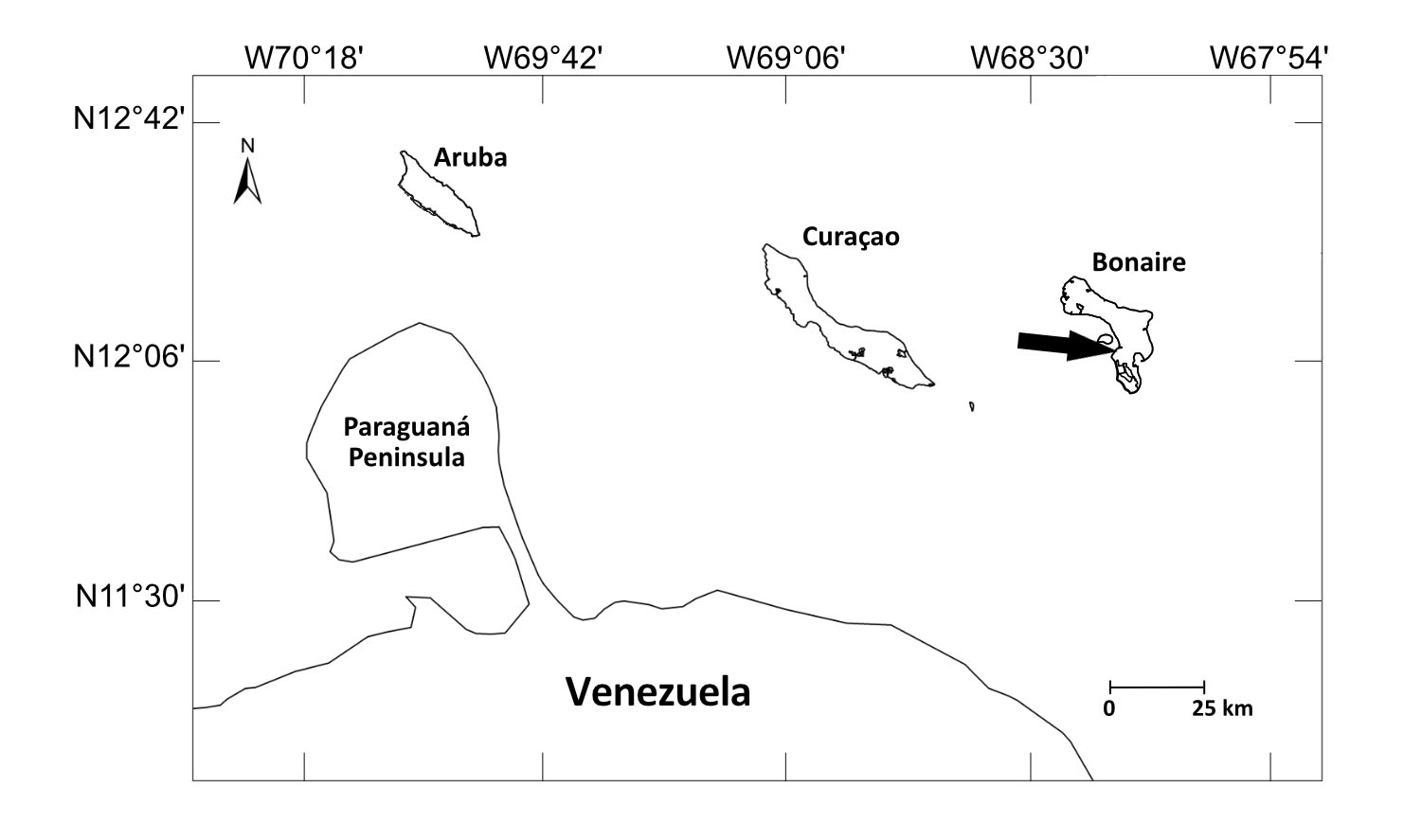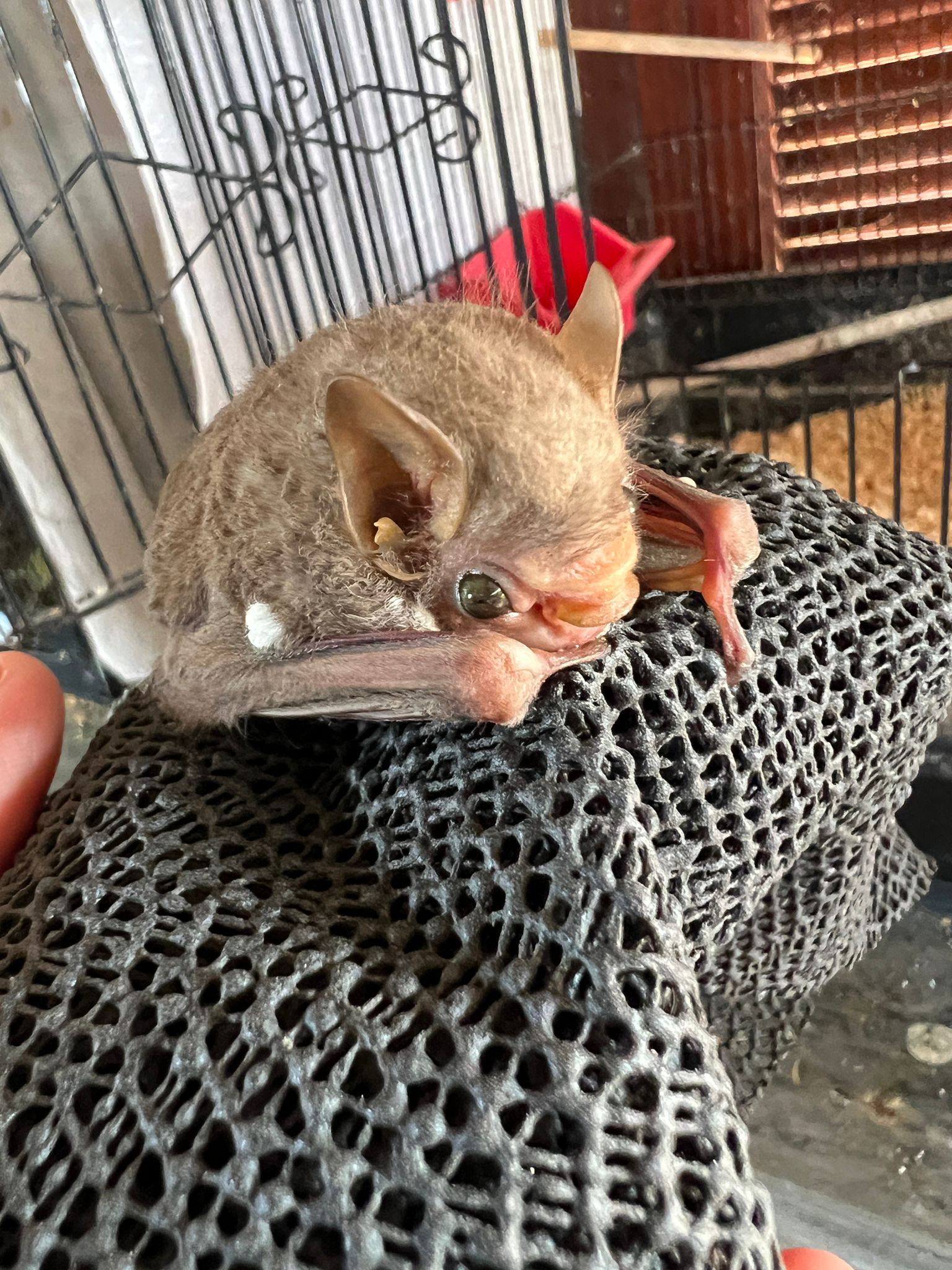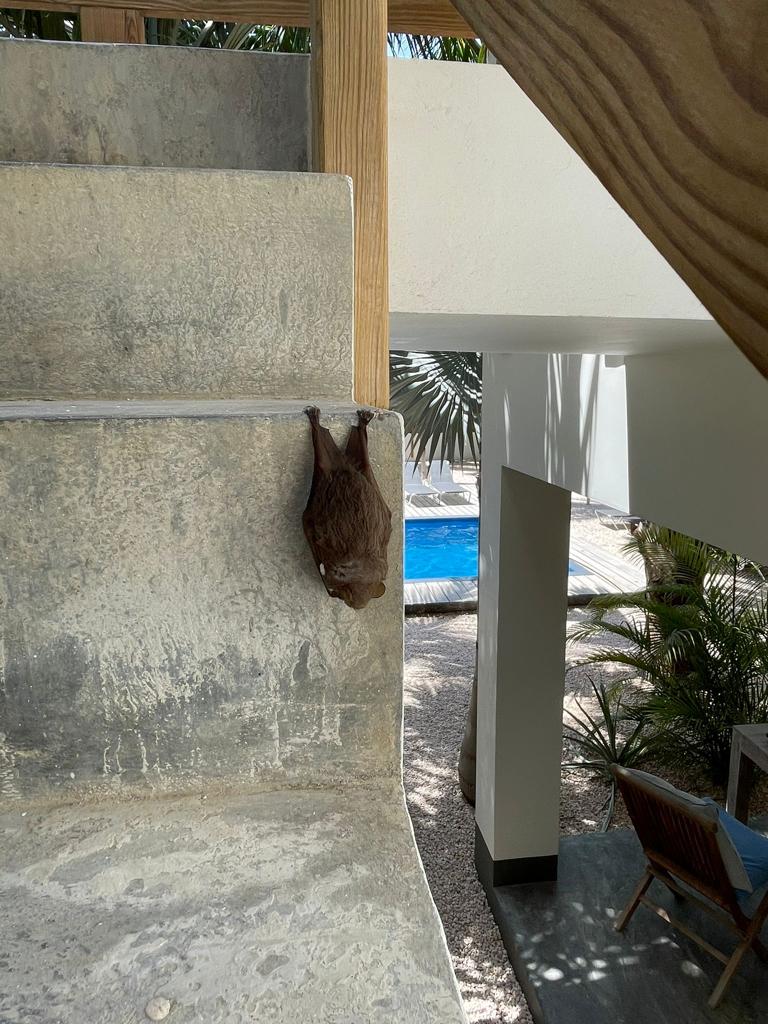1WILDCONSCIENCE. Kaya Platina 42, Kralendijk. Bonaire, Caribbean Netherlands. E-mail: fernando.simal@wildconscience.com (FS).
2Caribbean Research and Management of Biodiversity, Piscaderabaai. z/n, Willemstad, Curaçao. Caribbean Netherlands.
3Centro de Ecología, Instituto Venezolano de Investigaciones Científicas. Carretera Panamericana km 11, Caracas 1020-A. Miranda, Venezuela. E-mail: jafet.nassar@gmail.com (JMN).
*Corresponding author
Bats have great dispersal capacities and many species are capable of flying across areas of open sea while migrating, commuting, or foraging, covering a broad range of distances. Our goal is to report and provide possible explanations for the presence of a visored bat, Sphaeronycteris toxophyllum, captured on Bonaire Island, Dutch Caribbean. In October 2023, the bat was found alive hanging from the stairs of a resort on the west coast of Bonaire, pictures were taken and, immediately after, the animal was captured and transported to the Bonaire Wild Bird Rehabilitation Center. Taxonomic identification was conducted and the bat was properly maintained with food, hydration, and roost until its death. Then, the animal was preserved in ethanol. This is the first known record of S. toxophyllum for Bonaire and the ABC Islands. The specimen corresponds to a female, adult, non-pregnant, not lactating, weighing 19 g, and forearm length 40.3 mm. Stomach and intestines were examined and found empty, suggesting that the animal did not ingest food during the last hours or days before its death. We propose two possible explanations for the arrival of this bat in Bonaire, the animal either flew from Venezuela’s coast after getting disoriented, crossing nearly 90 km, or it was transported on a boat, used as a temporal roost, that had this island as destination. This finding illustrates the rare, but still possible, events of bat arrivals from the coasts of Venezuela into the ABCs and nearby islands.
Key words: Bonaire; Caribbean; seawater; Sphaeronycteris toxophyllum; visored bat.
Los murciélagos tienen una gran capacidad de dispersión y muchas especies pueden volar sobre mar abierto mientras migran, se desplazan o buscan alimento, cubriendo un amplio rango de distancias. Nuestro objetivo es informar y proponer explicaciones sobre la presencia de un murciélago de visera, Sphaeronycteris toxophyllum, capturado en Bonaire, Caribe Holandés. En octubre de 2023, el murciélago fue encontrado vivo, colgado en las escaleras de un complejo turístico en la costa oeste de Bonaire, fue fotografiado y luego capturado y transportado al Centro de Rehabilitación de Aves Silvestres de Bonaire. Se llevó a cabo la identificación taxonómica y fue mantenido adecuadamente con alimento, hidratación y refugio hasta su muerte. Después, el espécimen fue preservado en etanol. Se trata del primer registro de S. toxophyllum para Bonaire y las Islas ABC. El espécimen corresponde a una hembra, adulta, no preñada, no lactante, con 19 g y longitud del antebrazo 40.3 mm. El estómago y los intestinos se encontraron vacíos, lo que sugiere que el animal no ingirió alimento durante las últimas horas o días antes de su muerte. Proponemos dos posibles explicaciones para la llegada de este murciélago a Bonaire, el animal voló desorientado desde la costa de Venezuela, cruzando cerca de 90 km, o fue transportado en un barco, que usó como refugio temporal, con la isla como destino. Este hallazgo ilustra los raros, pero posibles, eventos de llegada de murciélagos desde las costas de Venezuela a las Islas ABC e islas cercanas.
Palabras clave: Bonaire; Caribe, mar; murciélago de visera; Sphaeronycteris toxophyllum.
Bats have great dispersal capacities and many species are capable of flying across areas of open sea while migrating, commuting, or foraging, covering a broad range of distances, from tens to hundreds of kilometers in a single night (Fleming and Nassar 2002; Ahlén et al. 2009; Shilton and Whittaker 2009; Thompson et al. 2015; Lagerveld et al. 2021; Solick and Newman 2021). These physiological and behavioral attributes of many bats make possible mainland-island and island-island colonization and recolonization events, helping explain the current and past distributions of many insular bat species worldwide. In the case of the Caribbean, the arrival of bats to the islands has been explained by dispersal events from mainland in most cases (Hedges 2001; Genoways et al. 2005).
Aruba, Bonaire, and Curaçao (ABCs) form the 3 wes-ternmost islands of the Dutch Caribbean, separated from Venezuela’s western coast by 30-90 km, depending on the island. In the case of Bonaire, the bat fauna recorded comprises 6 species, Natalus tumidirostris, Myotis nesopolus, Molossus molossus, Mormoops megalophylla, Leptonycteris curasoae, and Glossophaga longirostris (Hummelinck 1940; Genoways and Williams 1979; Smith et al. 2012; Simal et al. 2021). Our objective is to report and provide possible explanations for the first record of a visored bat, Sphaeronycteris toxophyllum Peters, 1882, (Phyllostomidae: Stenodermatinae), captured on Bonaire.
On October 1, 2023, around 14:00 hr, a live but exhaus-ted individual of Sphaeronycteris toxophyllum was sighted hanging from the stairs of Beaches Resort (12° 7’ 41.9” N, 68° 17’ 5.9” W), on the west coast of Bonaire (Figure 1). Pictures were taken (Figure 2), the animal was captured, and about half an hour later it was delivered to the Bonaire Wild Bird Rehabilitation Center, where the staff have the technical expertise to assist injured and sick bats. The individual was identified at the species level using external traits of the body and rostrum following taxonomic keys by Linares (1987) and Díaz et al. (2016). The animal was properly maintained with food, hydration, and roost until its death, 24 hrs later. On October 3, the fresh body was stored frozen (-20 °C) at WILDCONSCIENCE, Bonaire. Several months later, the specimen was dissected and preserved in ethanol and prepared to be shipped in 2025 to the Royal Ontario Museum, Canada (catalog number ROMM126634).
The external traits of the specimen corresponded to those described for Sphaeronycteris toxophyllum by Angulo et al. (2008), including reduced uropatagium, white spots on the shoulders, wings without horizontal bands, flattened and naked rostrum, swollen eyes, and a reduced inverted U-shaped nose leaf attached to a unique horizontal and fleshy outgrowth on the forehead (the visor). The specimen was an adult female, non-pregnant, not lactating, with a body weight of 19 g, forearm length 40.3 mm, ear width 6 mm, ear length 11.5 mm, and tragus length 3.1 mm. The stomach and intestines were examined and found empty, suggesting the animal did not ingest food during the last hours or days before its death.
Sphaeronycteris toxophyllum is considered an uncommon species throughout its geographical range in South America due to the small number of individuals recorded and collected (Emmons and Feer 1990; Angulo et al. 2008). Since no records of this species exist for Aruba and Curaçao (Hummelinck 1940; Husson 1960; Genoways and Williams 1979; Bekker 1996; Simal et al. 2021), we hypothesize that the individual captured in Bonaire either flew or was transported in a boat from Venezuela’s coast (closest linear distance to Bonaire ~ 88 km ) and arrived on the island on October 1 or the previous days. If the bat flew to the island, this implies that it was capable of crossing over open water nearly 90 km from Falcón State, in a north or northeastern direction, during the low trade winds season. This would be the most appropriate period of the year for this long-distance flight because winds reduce their speed (De Meyer 1998). However, bats are known to migrate hundreds of kilometers per night and have shown unexpected flexibility in their ability to migrate across a wide range of conditions (Hurme et al. 2025). Alternatively, the animal could have been transported by one of the small ships that transport fruit from Venezuela, although we think that a bat onboard would be easily disturbed during the operation of the ship before departing or during the trip. There are records of bats that use ships on high seas as temporary roosting sites (Thompson et al. 2015).
A search of the Global Biodiversity Information Facility (GBIF.org 2025) indicates there are 170 records for this species in Venezuela, 4 from the Falcón State. Two of these were from Boca de Yaracuy, 28 km WNW Puerto Cabello along the coast, ~ 169 air kilometers from the Beaches Resort with the others collected further inland. It is likely this species occurs in other areas along the northeastern coast of Venezuela. It has a wide distribution including open areas, evergreen and deciduous forests, ranging from sea level to 2,240 m (Angulo et al. 2008). The majority of bats recorded flying over seawater are either migrating or are aerial insectivores or piscivores actively foraging (Ahlén et al. 2009; Shilton and Whittaker 2009; Thompson et al. 2015; Aizpurua and Alberdi 2018; Lagerveld et al. 2021). However, S. toxophyllum is strictly frugivorous (Angulo et al. 2008), and the only abundant naturally occurring fruits eaten by frugivorous bats on Bonaire are produced by columnar cacti (Simal et al. 2021), and we found no records that these fruits are part of its diet on the mainland. This could explain why we found no evidence of food ingestion in the specimen when examined.
The discovery of an individual of S. toxophyllum arriving on Bonaire illustrates the rare, but possible inadvertent dispersal of bats from the coasts of Venezuela into the ABCs if they become disoriented while foraging, commuting at night, or transported while roosting on ships. For the ABCs, there are other records of bat species that are rarely observed on these islands and may also be the result of accidental arrivals. One individual of Myotis nesopolus was reported near Fountain Cave, Aruba, by one of us (FS) in March 2012, and 3 more at Quadirikiri Cave, Aruba, by a local research team (Simal et al. 2021), while conducting inventories of cave-dwelling bats on this island. This species was not included as resident in the list of mammals of Aruba (Bekker,1996), but it is present in the Paraguaná Peninsula, Venezuela (A. Martino pers. comm.), Curaçao, and Bonaire (Simal et al. 2021), and likely disperses occasionally to Aruba from one of those locations. An adult male Pteronotus davyi was captured and released on Bonarie in 2010 at Cave Orizjan (F. Simal and D. Simal pers. obs.). Prior to this record, this species was not included as occurring on Bonaire (Hummelinck 1940; Genoways and Williams 1979) and it has not been recorded since (Simal et al. 2021). This bat likely dispersed from Curacao, where it occurs (Simal et al. 2021). For Curaçao, Husson (1960) reported the presence of Ametrida centurio and Artibeus jamaicensis, but Petit et al. (2006) did not report these during several bat surveys conducted on Curaçao. However, in 2017, one individual Artibeus lituratus was captured on Rooi Rincon, Curaçao (collection number: ROMM126271, Royal Ontario Museum) by Burton Lim and one of us (FS) during a bat survey on the ABCs. Several authors have reported contemporary interisland dispersal events of A. jamaicensis in the Caribbean (Fleming and Murray 2009; Fleming et al. 2009).
In the majority of cases, such accidental arrivals of bats to the ABCs likely end up with the death of the animals before they have chances to become established or in sufficient numbers to reproduce, as was the case for the single female S. toxophyllum reported here. Under these circumstances, such records should not be included as part of the regular bat fauna present on these islands but noted as accidental arrivals. With the potential impacts of climate change, we cannot rule out the possibility of future colonizations from such dispersals, especially if arrivals are recurrent and sufficient roosting and food resources are available to maintain the colonizers until they reproduce. A program of systematic bat surveys over time on the ABCs could facilitate keeping track of these episodic bat arrival events from the mainland or nearby islands. For example, acoustic monitoring would be a cost-effective and non-invasive means of detecting aerial insectivores such as M. nesopolus, M. molossus, P. davyi, and others that may arrive from the mainland.
Acknowledgements
We thank E. Albers, head of the Bonaire Wild Bird Rehabilitation Center, for assisting the rescued bat and allowing access to its body after its death. Two anonymous reviewers provided valuable additions to the discussion and overall helped to improve the manuscript.
Literature cited
Ahlén, I., H. J. Baagøe, and L. Bach. 2009. Behavior of Scandinavian bats during migration and foraging at sea. Journal of Mammalogy 90:1318-1323.
Aizpurua, O., and A. Alberdi. 2018. Ecology and evolutionary biology of fishing bats. Mammal Review 48:284-297.
Bekker, J. P. 1996. The mammals of Aruba (Mammalia: Chiroptera, Rodentia, Lagomorpha). Vereniging voor Zoogdierkunde en Zoogdierbescherming. Oostkapelle, The Netherlands.
Díaz, M. M., et al. 2016. Clave de identificación de los murciélagos de Sudamérica. Publicación Especial No. 2, PCMA (Programa de Conservación de los Murciélagos de Argentina). Yerbabuena. Tucumán, Argentina.
De Meyer, K. 1998. Bonaire, Netherland Antilles. Pp. 141-149 in CARICOMP – Caribbean coral reef, seagrass and mangrove sites. Coastal region and small island papers 3. UNESCO. Paris, France.
Emmons, L. H., and F. Feer. 1990. Neotropical rainforest mammals. A Field Guide. University of Chicago Press. Chicago, E.E.U.U.
Fleming, T. H., and K. L. Murray. 2009. Population and genetic consequences of hurricanes
for three species of West Indian Phyllostomid bats. Biotropica 41:250-256.
Fleming, T. H., K. L. Murray, and B. C. Carstens. 2009. Phylogeography and genetic structure of three evolutionary lineages of West Indian phyllostomid bats. Pp. 116-150 in Island bats: Evolution, ecology and conservation (Fleming, T. H., and P. A. Racey, eds.). The University of Chicago Press. Chicago, Illinois, E.E.U.U.
Fleming, T. H., and J. M. Nassar. 2002. Population biology of the Lesser Long-Nosed bat, Leptonycteris curasoae, in Mexico and Northern South America. Pp. 283-305 in Evolution, ecology and conservation of columnar cacti and their mutualists (Fleming, T. H., and A. Valiente-Banuet, eds.). University of Arizona Press. Arizona, E.E.U.U.
GBIF.org. 2025. (17 January 2025) GBIF Occurrence Download https://doi.org/10.15468/dl.muwwqs
Genoways, H. H., and S. L. Williams. 1979. Notes on bats (Mammalia: Chiroptera) from Bonaire and Curacao, Dutch West Indies. Annals of Carnegie Museum 48:311-321.
Genoways, H. H., et al. 2005. Bats of Jamaica. Special Publications of the Museum, Texas Tech University 48:1-155.
Hedges, S. B. 2001. Biogeography of the West Indies: an overview. Pp. 15-33 in: Biogeography of the West Indies: Patterns and Perspectives (Woods, C. A., and F. E. Sergile, eds.). CRC Press. Florida, E.E. U.U.
Hummelinck, P. W. 1940. Studies on the fauna of Curaçao, Aruba, Bonaire and the Venezuelan Islands: No. 2. A survey of the mammals, lizards and mollusks. Rijksuniversiteit te Utrecht. 2:59-108.
Hurme, E., I. Lenzi, M. Wikelski, T. A. Wild, and D. K. Dechmann. 2025. Bats surf storm fronts during spring migration. Science 387:97-102.
Husson, A. M. 1960. De Zoogdieren van de Nederlandse Antillen. 2. Natuurwetenschappelijke Werkgroep Nederlandse Antillen. Curaçao, Dutch Caribbean.
Lagerveld, S., B. J. Poerink, and S. C. V. Geelhoed. 2021. Offshore occurrence of a migratory bat, Pipistrellus nathusii, depends on seasonality and weather conditions. Animals 11:3442.
Linares, O. 1987. Murciélagos de Venezuela. Cuadernos Lagoven. Caracas, Venezuela.
Shilton, L. A., and R. J. Whittaker. 2009. The role of pteropodid bats in reestablishing tropical forests on Krakatau. Pp. 176-215 in Island bats: Evolution, ecology and conservation (Fleming, T. H., and P. A. Racey, eds.). The University of Chicago Press. Chicago, E.E.U.U.
Simal, F., et al. 2021. Bat inventories at caves and mines on the islands of Aruba, Bonaire and Curaçao, and proposed conservation actions. Acta Chiropterologica 23:455-474.
Smith, S. R., et al. 2012. Preliminary inventory of key terrestrial nature values of Bonaire. Imares Wageningen UR. Report No. C003/12. 88 pp.
Solick, D. I., and C. M. Newman. 2021. Oceanic records of North American bats and implications for offshore wind energy development in the United States. Ecology and Evolution 11:14433-14447.
Thompson, R. H., A. R. Thompson, and R. M. Brigham. 2015. A flock of Myotis bats at sea. Northeastern Naturalist 22:N27-N30.
Associated editor: Arturo Carrillo-Reyes.
Submitted: February 16, 2025; Reviewed: March 18, 2025.
Accepted: March 20, 2025; Published online: May 14, 2025



